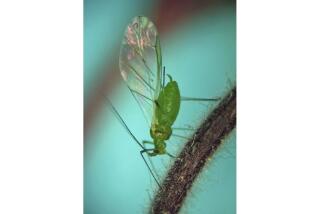Spring Is Here, and So Are Aphids
- Share via
Question: Aphids have appeared on my shrubs and roses. Is there anything I should do?
J.B., SANTA ANA
Answer: Aphids begin to show up in Southern California during the early spring. In most areas, they cease to be a serious problem after summer temperatures reach the 90s.
Aphids are small, soft-bodied insects with long, slender mouth parts that pierce stems and leaves and suck out plant fluids.
As they suck, they exude a sweet, sticky substance known as honeydew, which is attractive to ants. Aphids can be green, yellow, reddish or black and typically have 1/8-inch or smaller pear-shaped bodies, long legs and antennae.
Aphids give birth asexually to live young who resemble miniature adults and can multiply rapidly.
Limited numbers of aphids are not damaging to gardens, and a small number are actually a good thing, because they provide beneficial insects with a food source. A large population, however, can cause curling or yellowing of leaves, stunting of growth and damage to leaf and flower buds.
A few species can cause galls (swellings of plant tissues within which the insect lives) or other distortions in growth. Aphids can also transmit viruses that cause plant diseases.
Often the honeydew that aphids create as they feed is only a nuisance. It settles on plant leaves and underlying surfaces, such as walkways, is sticky and often turns black after contact with an airborne, sooty-black fungi. The honeydew also attracts ants.
There are a number of steps that can reduce the likelihood of aphid populations expanding to harmful levels in the garden. Consider the following:
* When selecting nursery plants, inspect the top and bottom of foliage for aphids and remove any pests found.
* Remove any build-up of weeds in the garden, which can harbor aphids.
* Plants that have nectar producing flowers, such as fennel, dill, lemon balm, nasturtium, scented gladiolus, lantana, parsley, honeysuckle and native plants, encourage the presence of aphid predators such as ladybugs and lacewings.
In addition to encouraging and conserving existing populations of aphid predators in the garden, it is also possible to introduce commercially available ladybugs (also known as ladybeetles) and lacewing eggs or larva.
Ladybugs and their larvae are voracious aphid predators, but when released they might not stay in your garden long enough to do any good. Before releasing them, spray them with sugar water, as purchased ladybugs are often thirsty and hungry and more likely to scatter. It is also helpful to wet the plants and soil if the weather is dry.
Release them in the late evening on the ground or on lower branches of plants, as a climb seems to discourage flight. You can also discourage dispersal by chilling them for an hour or two in the refrigerator before release.
Lacewings are generally purchased as larvae or eggs that can be sprinkled onto dry, aphid-infested foliage.
* Eliminating ants will make it easier for beneficial insects to control aphids. Trim trees and shrubs so that the only pathway ants can follow to foliage is the main stem. If a plant has a sturdy stem or trunk, then a sticky material such as Tanglefoot can be used as a barrier to the ants.
When using sticky barriers, do not apply them directly to the bark of young or thin-barked trees or shrubs or to heavily pruned trees, as the sticky material might be toxic to the plants. Wrap trunks with fabric tree wrap and apply the sticky material to the wrap. Do not leave it there indefinitely, as the wrapping material might cause damage as the plant grows.
* One of the easiest methods for controlling aphids is to wash them off with a strong spray of water. This also reduces the honeydew on foliage and can be done daily if necessary.
Other options are to spray foliage with insecticidal soap or a fine horticultural oil spray. Or you can ask a California Certified Nursery Professional for a recommendation.
Do not use a soap or oil spray on any plant that is water-stressed or when the temperature is above 90 degrees.
Because aphids are drawn to plant tissue with a high nitrogen content, it’s also important not to overfertilize.
Written by University of California Master Gardener in-training Harold Pope of Irvine.
University of California Cooperative Extension (UCCE) Master Gardeners are here to help. They are involved with a variety of outreach programs, including the UCCE Master Garden hotline, which provides answers to specific questions. You can reach the hotline at (714) 708-1646 or send an e-mail to ucmastergardeners@yahoo.com. Calls and e-mail are picked up daily and are generally returned within two to three days.






